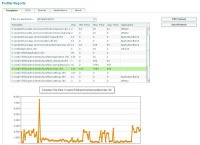Note: This blog post is from 2009. Some content may be outdated--though not necessarily. Same with links and subsequent comments from myself or others. Corrections are welcome, in the comments. And I may revise the content as necessary.
We all know that showing debug output to end users is a no-no, but sometimes don't you wish you (as an admin) could have access to what debugging info the users
would have seen while their requests are running? What if you could capture the debugging info to view it for all running requests, and better still, keep it for a short time to view about hundreds of recent requests?
Well now you can, if you have FusionReactor, by way of a simple 2-step process to configure CF to do this. You can learn more about it in this article Capturing ColdFusion's Debug Output in FusionReactor by Darren Pywell, CTO of Intergral (makers of FusionReactor).
In it, he explains what this is all about (a combination of using FR's API and the "markers" feature of the FR Request Detail page, in conjunction with CF's built-in feature to let you add and use new debugging templates). More important, he gives you all you need to know to set things up, from the simple snippet of code needed (downloadable) to a walkthrough of the simple steps needed to configure CF to hand the debugging output to FR. You can be up and running with this new capability in a matter of minutes (skip to the bottom for the "fast track" steps he offers, for proof.) Check it out.
But what about the performance impact?
And yes, he addresses briefly the performance and memory implications of using such a feature in production. You should certainly take care to ensure that doing this isn't causing any harm, especially if doing this in production. That said, I see lots of shops that leave debugging turned on and use the IP address limiting feature in the CF Admin, which many will argue is equally detrimental. I think a point to make is that the negative impact may be more "theoretical" to some than to others.
The bottom line, as he recommends, is that you should test such things before rolling them into production. Sadly, many shops can't or don't bother with testing (which is very unfortunate).
If you can't test the impact, measure it...with FusionReactor
At least then you should try to have some measure you can watch to see if processing is being in any way harmed, whether it's tracking fewer requests being processed per day, requests taking longer to run each time on average, more CPU being used by CF per day, and so on.
The very good news is that those who have FusionReactor can use FR's own tremendous logging to help report this kind of information. I talk about how to report against that using a tool like Microsoft's free Log Parser, in this page on the google group for FusionReactor.
I'll do a future blog entry on the tremendous logging that's possible. It far exceeds anything provided by any other tool, including the CF8 Server Monitor (which does no logging at all), and it does it with very low overhead.
So if you're using FusionReactor, check out the debug tool. It's very easy to enable and disable (via the CF admin, once you've added the new debugging template). It's also a useful demonstration of the FRAPI.
And if you don't have FusionReactor, check that out, too. I use it or help people use it every day to solve CF problems. It's much more than "just a monitor". For more info, see the site's many resources (brief feature highlights, docs, online help, a live demo, mailing list, and more). See also some of the other entries I've done here on FusionReactor.








